Article contents
Cremation and Burial in the Ṛgveda
Published online by Cambridge University Press: 15 March 2011
Abstract

- Type
- Miscellaneous Communications
- Information
- Copyright
- Copyright © The Royal Asiatic Society 1912
References
page 470 note 1 See i, 481–551.
page 470 note 2 i, 514.
page 470 note 3 Cf. “Minos the Destroyer” (Brit. Acad. Proceedings, iv), p. 28. But we have no real evidence of what the Dorians did for centuries after their entry into Greece, and this argument from their later usages is not cogent.
page 470 note 4 “Who were the Dorians?” in Anthropological Essays presented to E. B. Tylor, pp. 295 seqq. Murray, , Rise of the Greek Epic 2, p. 61, n.Google Scholar, suggests that the Dorians were the tribe of the hand (δ⋯ρον), quoting the lambda on their shields. Unhappily for this wild guess, δίδωμι does not mean “moving the hand” either in Greek or in Sanskrit.
page 470 note 5 i, 429, 439, 495–8.
page 471 note 1 See e.g. Sergi, , The Mediterranean Race, 1901Google Scholar; Ripley, , The Races of Europe, 1900Google Scholar.
page 471 note 2 i, 532 seqq.
page 471 note 3 x, 15. 14.
page 471 note 4 xviii, 2. 34.
page 471 note 5 pároptāḥ refers perhaps to exposure (as in Iran) of the dead body to the elements and the birds and beasts, a practice not unknown in later India (see Smith, Vincent, Early History of India 2, pp. 143, 144Google Scholar; Nariman, , JRAS. 1912, p. 257)Google Scholar; úddhitāḥ to exposure on a platform or tree.
page 471 note 6 Religion des Veda, p. 571. He does not, however, suggest that burial was not known.
page 471 note 7 x, 18. 9–13. See also Atharvaveda, xviii, 2. 50–2.
page 471 note 8 Oldenberg, op. cit., p. 580.
page 472 note 1 The Tasmanians, pp. 128 seqq. Cf. Lang, , The World of Homer, pp. 4Google Scholar, 105–12.
page 472 note 2 It is accepted by Burrows, , Discoveries in Crete, pp. 209–13Google Scholar. Dörpfeld's, ingenious view (Mélanges Nicole, pp. 95 seqq.)Google Scholar that in all cases burial took place, but in some scorching (occasionally leading to complete burning) as a quasi means of embalming, is quite impossible in view of the language of Homer as well as archæological evidence. It is, however, probable that the use of ταρχ⋯ɛιν in II. vii. 85; xvi, 457, is a proof that Homer knew of burial as an alternative, as Zehetmaier, (Leichenverbrennung mid Leichenbestattung im alten Hellas, pp. 121, 122)Google Scholar argues. Zehetmaier is not a believer in the racial distinction of modes of burial, and it is hard to see what ground there is a priori for acceptance of the theory.
page 473 note 1 It may have been aristocratic, but aristocracy is not necessarily racial, and Homer is doubtless in part aristocratic, but he describes the burning of the ordinary soldier as well as of the chief (e.g. Elpenor's burial; cf. Lang, , Homer and his Age, p. 99)Google Scholar. Murray, , Rise of the Greek Epic 2, p. 96Google Scholar, lays stress on the desire to avoid harm to the body of the dead, which is not, however, altogether consistent with the raising of a mound over the ashes, and he does not insist that it was introduced merely by the northern invaders (whom he brings to Mykenai in the time of its burials).
page 473 note 2 The Celtic theory is not to be pressed; that the Greek invaders were Āryans is clear; that they spoke before the invasion during a sojourn in the Danubian region an Āryan tongue is also clear, and probably it would approximate more closely to the Teutonic and Celtic speeches than it did later—though we do not know for this early period the nature of the Teutonic and Celtic speeches or their differentiation (if the differentiation which is usually ascribed to a racial mixing of the Celts had commenced). But that the Achæans were really Celtic in any precise sense is a priori improbable, and the labialism argument has been refuted by Monro, , Homer's Odyssey, p. 487Google Scholar.
page 473 note 3 Ionians, Pelasgians perhaps, and Minyai must be reckoned here with others. The Achæans may have been and probably were later comers than these.
page 473 note 4 The end of late Minoan (or Cnossus) II. It seems to follow the sack of the palace about 1400 B.C., see Burrows, pp. 94–7, which Ridgeway accepts. Probably Greeks were in Greece proper for sonic generations or possibly centuries earlier; Hall, Oldest Civilisation, of Greece, went perhaps too far in ascribing to them a large influence on the Minoan culture. Burrows, pp. 146, 194, shows the evidence against the Indo-European character of the language of the Mediterranean nice as derived from traces of it in Egyptian, in Welsh, and Irish as compared with Berber and Egyptian. See also Kretschmer, Gesch. d. griech. Sprache, and Fick, Vorgriechische Ortsnamen and Hattiden und Danubier in Griechenland. Conway's, view (BSA. viii, 125 seqq.; x, 115 seqq.)Google Scholar that this language is Āryan is based on a series of improbable suppositions, and is rightly rejected by Burrows (pp. 151 seqq.) and Murray.
page 474 note 1 See i, 495, 500, 503, 506, 548. He regards the Hindus as making their way into India before the beginning of the iron age, 1400 B.C., and “How much earlier who can say?” But there is no conclusive evidence to prove that the Indians came from Central Europe (the pros and cons are too evenly balanced to render any opinion useful), and there is certainly none as to the date of the beginning of the iron age there or elsewhere in Europe at 1400 B.C.
- 1
- Cited by




